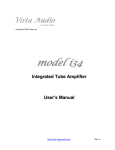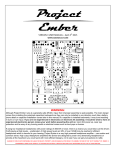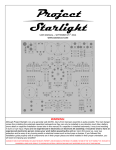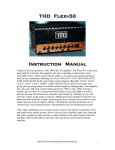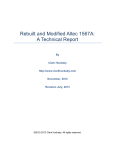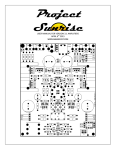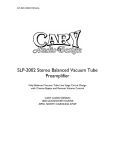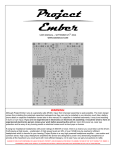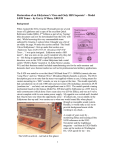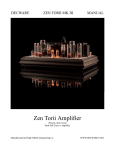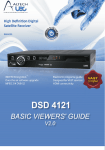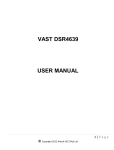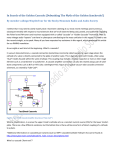Download maxipreamp user manual
Transcript
maxipreamp user manual introduction Thank you for your purchase of the MaxiPreamp Digital Tube Tester, a multi-function measurement station for preamplifier vacuum tubes. This instrument is the result of over 6 years of engineering development and has a combination of testing capabilities never before achieved in such a compact package. The Maxi-Preamp is simple to use and quick to understand, and a few minutes spent reading this manual will familiarize you with the operation of the instrument. The Maxi-Preamp is an entirely new approach to preamplifier tube measurement and it is the most comprehensive tester yet in its testing capabilities. It mounts up to four tubes at a time, and can simultaneously measure one tube while heating and stabilizing three others. The instrument uses two proprietary high-performance current sources, an independent circuit for each section of a tube under test, to create the most accurate results possible for today’s demanding listeners. Measurements are scanned by a single precision analog to digital converter to keep crosstalk and destabilization to a minimum. Operational control of the unit and test-result calculations are accomplished by a custom-programmed microprocessor feeding the backlit LCD display. The instrument has separate controls for Measurement Function, Gain Type, Socket Select, Audio Output Level and Section Listen. The Function control selects the type of test, while the Gain type calibrates the tester for high, medium and low Mu tube types. The Output Level controls the audio level at the dual RCA jacks, and the Section Listen switch allows you to audition each amp in a dual triode individually. The Noise Test is calibrated in absolute dBV = 1 Vrms and is an audiobandwidth True RMS measurement. introduction, cont. measurement functions Each test socket has in front of it two dual-color LEDs indicating operational status for the two amp sections in a dual triode - you get eight individual testers in one package! All tests are continuously sampled, averaged and then updated to give the most accurate measurements. Test results are displayed simultaneously for both sections in the LCD display and updated 4 times each second. what is measurement? The Maxi-Preamp can be used by the electronics tech, music store sales-person or audiophile enthusiast to quickly test a tube for quality and function. Each of the four test sockets has two bi-color LEDs indicating operational status for the two amp sections in a dual triode - you get eight individual testers in one package! All tests are continuously sampled, averaged and then updated to give the most accurate measurements. Test results are displayed simultaneously for both sections in the LCD display and updated 4 times each second. • Measure preamp tubes for Gain, Transconductance and Noise • Test any common dual or single preamp triode • Audition tubes with dual-RCA Direct Audio Output • Scanning Digital Sampling Converter for highest accuracy • Continuously sampled/averaged/updated measurements • Displays both results on LCD simultaneously • Bi-color operational status LEDs for each tube section • Two proprietary matched current-source drive circuits • An entirely new approach to signal tube testing Vacuum tubes are active devices that are dependent on the circuits in which they work. The factors they exhibit change depending on how they are measured. We have all seen the various graphs showing tube data curves. These graphs represent a tube’s behavior at various operating points of plate voltage, current, input voltage etc. Note that the graphs are curves - tube behavior varies depending on which operating points are chosen as test constants. The function of a tube tester is to provide a common environment in which to compare different tubes with each other. Any given tube tester has its specific operating points that it presents to a tube. Thus, measurements can and usually do differ between testers. This does not mean the data are incorrect. It only means that the testers are using different standards to measure a tube. Published data for tubes showing a certain number, say for transconductance, must also show the other circuit values it was achieved with, or it is meaningless. 1) Gain Measurement Gain is the factor by which an amplifier multiplies a signal. It is the product of the output voltage at the plate divided by the input voltage at the control grid. Gain is a unit-less factor since both measured signals are voltages. The MaxiPreamp uses a resistance-coupled voltage gain circuit with a constant current feature for gain measurement. Each triode element is furnished with a constant current (1, 2, or 4 milli-amps as set by the Gain Type switch). A calibrated signal is applied to each control grid and the resulting change in plate voltage across the load resistor is measured. Samples are captured every 150 milliseconds, and the microprocessor then calculates the signal gain as Mu (µ) = change in Vplate / change in Vgrid. Data are averaged and then updated 4 times per second in the LCD display. measurement functions, cont. switches and controls 2) Transconductance measurement 1) Gain Type switch Transconductance is a measurement of the ability of a tube to transmit current. It is the product of the output current in amps divided by the input voltage at the control grid. Transconductance is significant in that it shows us the difference in current capability that is generated by variations in plate impedance between tubes. This control changes the plate current and cathode resistor in each triode circuit to compensate for various tube types. Here is a chart showing the various voltages, currents and cathode resistors in use. This function in the Maxi-Preamp utilizes a cathode-follower circuit with a constant voltage low impedance plate supply. Each triode plate in a pair is supplied with a constant voltage. A calibrated signal is applied to the control grid inputs and the resulting change in cathode current is measured. Samples are captured at the tube cathode every 150 milliseconds, and the microprocessor then calculates the transconductance as Gm = change in Iplate / change in Vgrid. Data are averaged and then updated 4 times per second in the LCD display. 3) Noise measurement Each triode is configured as a resistance-coupled amplifier with the control grid AC coupled to ground. Microphonics and thermal (Johnson) noise are expressed across the output resistor and amplified by a differential instrumentation amp with a gain of 1000. The amplified noise signal is fed to a precision RMS-to-DC converter where the true RMS value of the bandwidth-limited (20Hz–20kHz) noise signal is measured. The value of the noise signal is referenced to absolute dBV and represented as decibels below 1 Vrms. The measurement is presented on the LCD for one triode (A or B) at a time using the Tube Section switch. A peak detector circuit captures the maximum signal value within any given update period and displays that value until the next update. Therefore if a tube is tapped during noise testing, the peak value of that noise is displayed. The noise signal is also fed to the adjustable gain audio amplifier for output at the dual RCA output jacks on the front panel. The Tube Section switch controls which triode is being auditioned at the RCA jacks. The audio level at the jacks is controlled by the Noise Level knob. Audio output and tube section select are only available in the Noise Test function. Gain Ip Gain Vc Gm Vp Gm Rk Noise Rp Noise Rk High Mu 1 mA -1 VDC 200 VDC 1KΩ 100 K Ω 1kΩ Med Mu 2 mA -3 VDC 200 VDC 1.5k Ω 100 K Ω 1.5k Ω Low Mu 4 mA -6 VDC 200 VDC 1.5k Ω 100 K Ω 1.5k Ω Ω It is recommended that suggested Gain Type settings be used. While other Gain Type settings than what is recommended on the front panel may be used, spurious or out of range data may result. For instance, measuring a medium-Mu triode such as a 12AU7 in the High range setting results in an out of range statement. Using a low or medium gain setting for a hi-gain triode such as a 12AX7 results in a mismatch of tube impedance and power supply input resulting in incorrect measurement. However, neither the tube nor the MaxiPreamp will be damaged by this action, so it is possible to explore the various combinations of gain and triode type. 2) Function switch This switch controls which measurement and which circuit configuration is being applied to each tube under test. Note that the audio output is disabled in either the Transconductance or Gain test. switches and controls, cont. tube testing procedures 3) Tube Select switch 1 Insert provided IEC power cable into rear AC inlet. Turn power switch on. The backlit LCD will illuminate and indicate which test is currently selected. 2 If listening tests are desired, connect either of the dual RCA output jacks to any line-level input device such as a mixer or receiver line input. 3 4 Install up to four tubes into the test sockets. Referring to chart on the front panel, select Gain Type. Allow for 2 minutes warm-up time. This control selects which socket of the four test sockets is being addressed. Switching between tubes can be done under all settings and conditions. No damage to the tester or to any tube will result. 4) Tube Section This control selects which triode of a pair is being auditioned and measured by the RMS converter. 5) Noise Level control This control selects the audio level being sent to the RCA output jacks. Note that some noise is present even when no tube is mounted in a socket. The tester has an internal noise floor of -92 dBV. Select desired measurement function. Results will appear in the LCD display. For Gain and Transconductance testing, results for both A and B section are displayed at the same time. For Noise testing, results for either A or B are displayed depending on which is selected using the Tube Section switch. 5 Each test socket has two bi-color LEDs in front of it. These indicate operational status for the tube section under test. In normal operation mode, both LEDs are lit in Gain and Transconductance testing, as both sections are being tested simultaneously. In Noise Test mode, only one of the two LEDs is lit, indicating which section is being tested. In the event a shorted tube is sensed, the LED on that section will turn red indicating failure. maxi preamp specifications Directly testable tube types (base 9A) 12AX7, 12AU7, 12AT7, 12AY7, 12DW7, 12BH7, ECC81, ECC82, ECC83, 7025, 5751, 5814 and all other 9A tubes Optional tube types (with adaptor) 6DJ8, 6922, 6CW7, 6AQ8, 6GM8, 6EU7, 6CG7, 6FQ7, 6N1P, 5687 Measurement Functions Transconductance (Gm, mA/Volt) Range 0 – 5000 µmhos (Siemens) Gain (Mu, µ) Gain Range 0 – 120 Noise (0 dBV = 1VRMS) Noise floor -92 dBV – 0 dBV Max Gain (Mu, µ) Gain Range 0 – 120 Noise (0 dBV = 1VRMS) Noise floor -92 dBV – 0 dBV Max Gain Types – dual triodes High Mu Medium Mu Low Mu 1 mA Icathode 2 mA Icathode 4 mA Icathode Gain specification chart Gain Ip Gain Vc Gm Vp Gm Rk Noise Rp Noise Rk High Mu 1 mA -1 VDC 200 VDC 1KΩ 100 K Ω 1kΩ Med Mu 2 mA -3 VDC 200 VDC 1.5k Ω 100 K Ω 1.5k Ω Low Mu 4 mA -6 VDC 200 VDC 1.5k Ω 100 K Ω 1.5k Ω Filament voltage................ 6.3 VDC regulated Filament current................ 1.5 A DC Maximum Plate Voltage..................... 200 VDC regulated AC input mains.................. 120 (240 Euro) VAC / 50 Watts Dimensions........................ 12.5” (317 mm) x 8.5” (215 mm) Shipping Weight................ 9 lbs. 4 Oz. (4.20 kilo) 92 < h g i H 7 X A 12 17> < w o L 7 U A 12 0> 5 < d e M 7 T A 12 0> 4 < d e M 12AY7 /20> 0 9 < d i/Me H 7 W Maxi-Test 12DLLC 6> 1 < 125 North 36th Street | Seattle WA USA 98103 w o L phone 206-633-5190 fax H 206-633-0803 7 B 12 www.maximatcher.com ECC81 ECC82 ECC83 7025 6DJ8 6922 60> < d e M 17 < w o L 2 High < 9 2 High < 9 2 Med < 2 Med <









